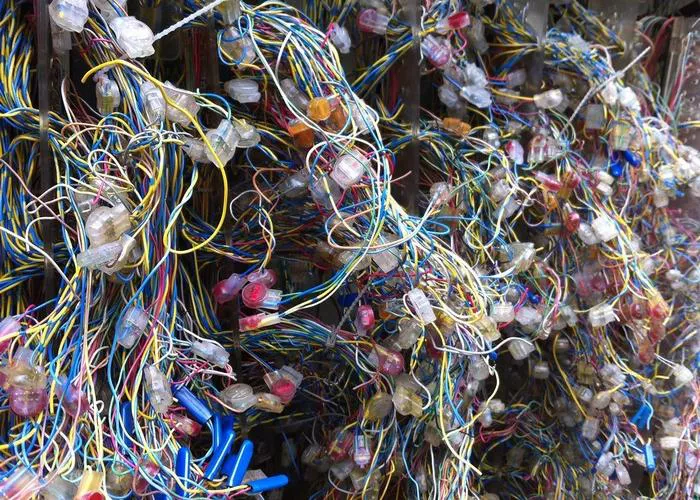Romex, a brand name commonly associated with non-metallic sheathed electrical cable, is a staple in residential and light commercial wiring. This article explores the various types of wires within Romex, their materials, configurations, applications, and the overall significance of this cable type in electrical systems. Understanding the type of wire in Romex is crucial for electricians, contractors, and homeowners tackling DIY projects.
What Is Romex Cable?
Romex is a trademarked name by Southwire, referring to a family of non-metallic (NM) sheathed electrical cables. NM cable is widely used in interior electrical installations due to its ease of handling, cost-effectiveness, and compliance with the National Electrical Code (NEC).
Romex cable consists of multiple insulated conductors encased in a non-metallic, flexible sheath. This sheath provides protection during installation and limited environmental resistance. The wires within Romex are specifically designed to carry electrical current safely while minimizing risks such as short circuits or overheating.
Types of Wire Inside Romex Cable
Romex cable typically contains the following wire types:
Hot Wire (Live Wire):
Material: Copper or aluminum.
Insulation: The hot wire is usually insulated in black or red thermoplastic material.
Purpose: This wire carries the electrical current from the power source to the intended outlet, switch, or fixture.
Neutral Wire:
Material: Copper.
Insulation: White thermoplastic insulation.
Purpose: The neutral wire completes the electrical circuit by returning the current back to the power source.
Ground Wire:
Material: Bare copper or sometimes aluminum (though less common in modern installations).
Insulation: Typically uninsulated or covered in green insulation for certain variations.
Purpose: The ground wire provides a safe path for electricity in the event of a fault, minimizing the risk of electrical shock or fire.
Materials of Wires in Romex
1. Copper Wires
Copper is the most commonly used material in Romex wiring. Known for its excellent electrical conductivity, durability, and resistance to corrosion, copper ensures safe and efficient electrical transmission. Copper wires in Romex are often annealed to enhance flexibility during installation.
2. Aluminum or Copper-Clad Aluminum Wires
Some Romex cables, especially older installations, use aluminum or copper-clad aluminum wires. While lighter and cheaper than copper, aluminum has a higher electrical resistance and is less durable over time. Copper-clad aluminum improves some of these characteristics by adding a layer of copper over an aluminum core.
Sizes and Configurations
Romex cables come in a variety of sizes and configurations to suit different applications. The size of the wire, measured in American Wire Gauge (AWG), determines its current-carrying capacity. Common Romex wire sizes include:
14 AWG: Rated for 15 amps; suitable for lighting and standard receptacles.
12 AWG: Rated for 20 amps; used for outlets and small appliances.
10 AWG: Rated for 30 amps; used for larger appliances such as water heaters or air conditioners.
8 AWG and 6 AWG: Rated for 40-60 amps; used in specialized circuits like sub-panels or heavy machinery.
A typical Romex cable is identified by a designation such as “12/2” or “12/3”:
12/2: Contains two insulated conductors (hot and neutral) and one bare ground wire.
12/3: Contains three insulated conductors (hot, hot, and neutral) and one ground wire, often used for split-phase circuits.
Insulation in Romex Wires
The individual wires in Romex are insulated with thermoplastic material, such as PVC (polyvinyl chloride). This insulation serves as a barrier to prevent electrical shorts and protects against heat generated by electrical currents.
Modern Romex cables feature additional innovations in insulation:
THHN (Thermoplastic High Heat-resistant Nylon-coated): A common insulation type that provides heat resistance and added durability.
THWN (Thermoplastic Heat and Water-resistant Nylon-coated): Adds water resistance for damp locations, though standard Romex is not intended for outdoor or wet applications.
Applications of Romex Cable
Romex is designed for indoor, dry-location use. It is commonly found in:
Residential Wiring: Powering outlets, lights, and appliances.
New Construction: Running wiring through walls, ceilings, and floors.
Remodeling Projects: Rewiring older homes to meet modern electrical codes.
Safety Considerations
While Romex cable is widely used, its proper installation and handling are crucial for safety and compliance with the NEC.
Avoid Overloading Circuits: Use the correct wire gauge to handle the expected current.
Use Proper Fasteners: Secure Romex cables using approved clamps or staples to prevent damage to the sheath.
Protect Against Physical Damage: Avoid running Romex in exposed areas where it could be subject to wear or punctures.
Ground Connections: Always ensure the ground wire is properly connected to reduce the risk of shock.
Romex Alternatives
While Romex is the standard for residential use, other types of cables may be used depending on the application:
BX Cable (Armored Cable): Features a flexible metallic sheath for added durability in exposed locations.
UF Cable (Underground Feeder): Designed for direct burial and outdoor use with waterproof insulation.
MC Cable (Metal-Clad): Combines flexibility and durability with an aluminum or steel sheath.
Advantages of Romex Cable
Ease of Installation: Flexible and easy to pull through walls and ceilings.
Cost-Effective: Less expensive than armored alternatives like BX or MC cable.
Versatile: Available in a wide range of sizes and configurations.
Conclusion
Romex cable, a leading choice in electrical wiring, consists of high-quality materials such as copper or aluminum, insulated with durable thermoplastic. Its design incorporates hot, neutral, and ground wires, ensuring safe and efficient electrical circuits. Understanding the wire types and configurations within Romex is essential for proper installation and long-term safety.
By adhering to electrical codes and best practices, Romex cable continues to be a reliable solution for powering modern homes and light commercial spaces. Whether you’re an electrician or a DIY enthusiast, recognizing the components of Romex enhances your ability to create safe, effective wiring systems.

